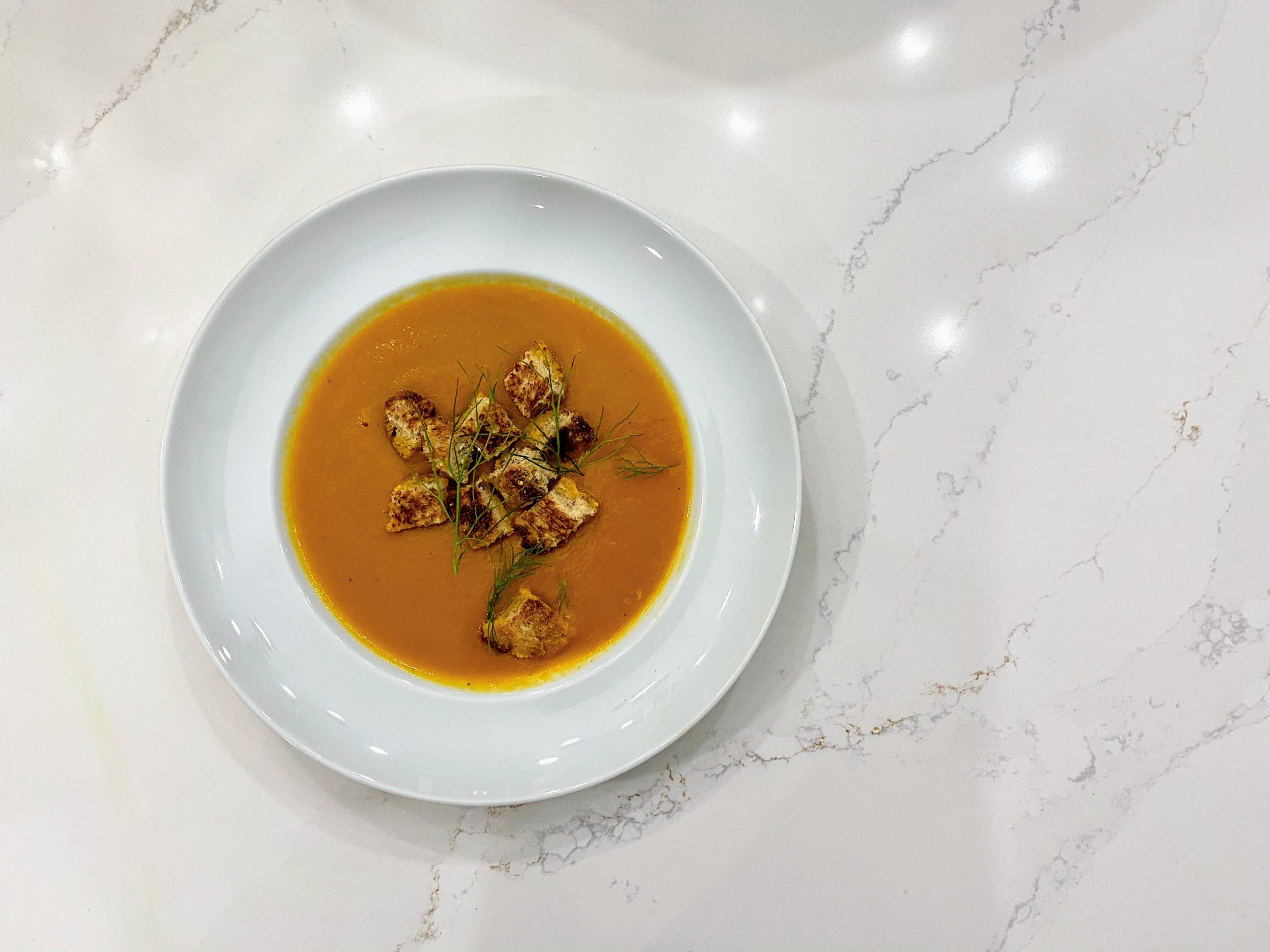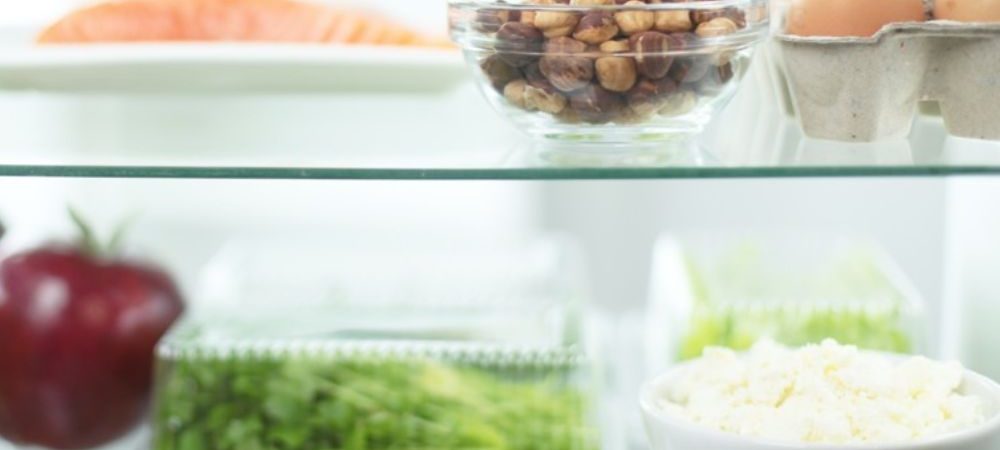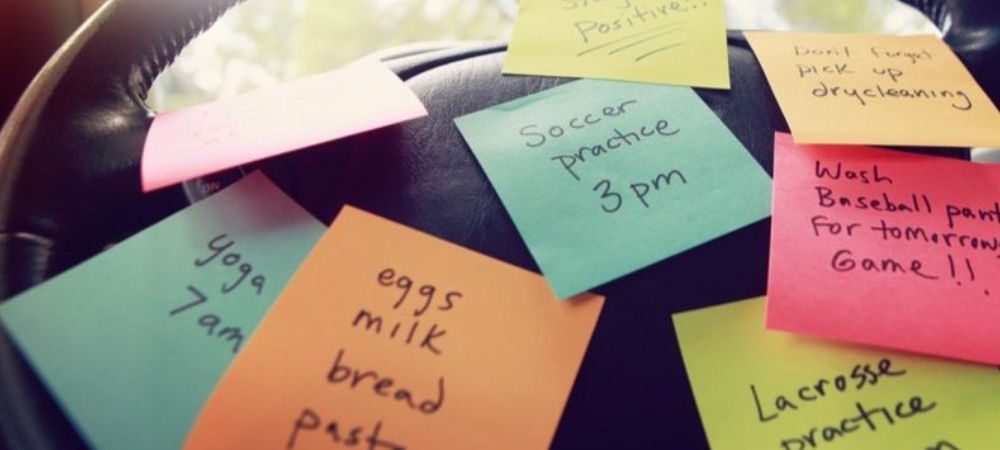Food prices are impacted by the inflation. This empty fridge soup is an easy way to reduce your food costs and your food waste.
In this blog we discuss
- Empty fridge soup recipe
- Soup preparation tips
- Crouton recipe
- Food price forecast
- Food waste
Canada's food price forecast
Canada’s Food Price Report, published by Dalhousie University and the University of Guelph predicts the highest increase in dollars of the report’s history. An increase of 695$ for a total of 13,907$ is the anticipated food cost of a family with 2 adults and 2 children – This amount DOES NOT include ANY food service.
Food waste
The average household waste 309 lbs/year of food – worth on average 1,100$!
The comestible waste throughout the food chain is estimated at 11.2 million tons. To better understand how much food that represents we need to break it down. 11.2 million tons of food is enough to feed ALL Canadian for 4.9 months!
What can we do?

As a starter, main course, side dish or as a sauce, soups can transform yesterday’s leftovers and less appetizing vegetables into tasty new dishes. It’s one of the fastest, easiest, and most delicious ways to use up the foods in your fridge and pantry!
Empty Fridge Soup
Ingredients
- 1 Onion
- 1 tbsp Butter or vegetable oil
- 5 cups of mixed vegetables or 1 single vegetable cut into slices or quarters (e.g. carrots, turnip, squash, broccoli, cauliflower, leek)
- 5 cups of liquid of your choice
- Salt and pepper, to taste
Preparation
- In a saucepan, soften the onion in the butter. Add the vegetables and broth. Bring to a boil. Simmer for about 20 minutes.
- Optional – In a blender, reduce the soup to a smooth puree. Salt and pepper.
Optional ingredients

Optional soup ingredients
Add these ingredients with the vegetables and broth.
- Parmesan rind – remove before blending. It will add umami to the soup
- Potato, mashed potatoes, rice, grains. Add about 1 cup. It will thicken the soup.
Soup liquid ideas
You can include a combinations of liquid.
- water
- vegetables broth
- chicken/beef broth
- cream (1/2 cup)
- coconut milk (1/2 cup)
- orange or apple juice (up to 1 cup)
Fine herbs &/or spices by vegetable type
Add these ingredients with the vegetables and broth.
- Orange vegetables
- Cumin (1 tsp) ginger (1 tsp)
- Ginger (1 tsp), turmeric (1/2 tsp), pepper (1/8 tsp), cinnamon (1/2 tsp), nutmeg (1/4 tsp)
- Curry (1 tsp), turmeric (1 tsp), pepper (1/8 tsp), 1 lemon (zest and juice add after the coup is cooked)
- Varied vegetables
- Bay leaf (1), thyme (1/2 tsp)
- Oregano (1 tsp), basil (1 tsp)
- Provence herbs (2 tsp)
- Italian herbs (2 tsp)
- Green vegetables
- Dill (to taste), Greek yogurt (to taste)
- pesto (2 to 3 tbsp)
Garnishes
Use to decorate the soup.
- Croutons – see recipe below
- Herbs
- Parmesan
- Meat (crispy bacon, leftover chicken,…)
- Cream / Greek yogurt
- Lemon or orange zest
- Pesto
Soup preparation tips
1. To make the soup pretty, use vegetables of the same color. When you mix all the leftover vegetables for a soup, the soup can be a little brown. From today, your soups will be vibrant with different color combinations.
- Orange produce
- sweet potato, carrots, squash, pumpkin, bell peppers,…
- Green produce
- Broccoli, spinach, lettuce, fennel, leeks, …
- Neutral produce
- potatoes, cauliflowers, parsnips, rutabaga, apples,…
- Neutral produce can be added to any colour soup or can be used to make a very lightly coloured soup.
2. To control the thickness of your soup, you can remove about 1 cup of the broth before blending and add it back as desired.
Croutons recipe

Since we are making an “empty fridge soup” might as well double up on the waste reduction and make croutons with leftover or dried bread. Home made croutons taste nothing like store bought ones. They are filled with layers of flavours. Get ready to fall in love with croutons!
Ingredients
- Leftover bread – about 4 cups
- Oil – 1 tbsp
- e.g. cameline, olive, grapeseed oil, avocado
- Dried herbs of choice – 1 tbsp
- e.g: Italian spices, provence, basil, oregano.
- Salt & pepper
Preparation
Preparation
- Heat the oven to 375F. Line a baking sheet with parment paper or a silicon cooking mat.
- Cut the bread in 1/2 to 1 inch cubes. Place the bread cubes on the lined baking sheet.
- Drizzle the bread with oil, herbs, salt & pepper.
- Combine with your hands and place in a single layer.
- Bake 15 minutes. Let cool.
Why homemade croutons?
- Home made croutons cost lest than half the price of store bought ones and taste a lot better.
- The ingredient list is simple and high quality.
- Reduce food waste by using bread that may have ended up in the garbage.
Canada's food price forecast

Canada’s Food Price Report, published by Dalhousie University and the University of Guelph predicts the highest increase in dollars of the report’s history.
The 2021 food price forecast is as follows:

Credit: https://cdn.dal.ca/content/dam/dalhousie/pdf/sites/agri-food/Food%20Price%20Report%202021%20-%20EN%20(December%208).pdf
The 2021 report forecasts that overall food prices will increase 3 to 5%.
An increase of 695$ for a total of 13,907$ is the anticipated food cost of a family with these members:
- a man (age 31–50)
- a woman (age 31– 50)
- a boy (age 14–18)
- a girl (age 9–13)
This amount does not includes any food service expenses.
Food Waste

Household food waste
The average household waste 309 lbs/year of food – worth on average 1,100$!
Food chain total waste
In Canada, 58% of the food produced is wasted throughout the food chain – a total of 35,5 million tons. This includes non comestible foods like eggshells and bones. The comestible waste throughout the entire food chain is estimated at 11,2 million tons.
To better understand how much food that 11,2 million tons represents we need to break it down. Here are the maths:
- How much food is that per Canadian?
- 11,2 millions tons of food/ 37.6 million canadians = 0.3 tons/Canadian
- 1 ton = 2000 lbs
- 0.3 tons = 600 lbs
- How long does it take to eat this amount of food?
- The average person eats 4 pounds a day.
- 600/4 = 150 days of food
- 150 days = 4.9 months
This 11,2 million tons of food is enough food to feed each Canadian for 4.9 months!
Global food waste
Food waste is an important global issue globally. Here are some numbers to better understand the impact of food waste:
- 1/3 of the food produced in the world is lost or thrown away, equivalent to around 1.3 billion tonnes per year
- Food produced but not consumed unnecessarily occupies nearly 1.4 billion hectares of land, which is the size of Canada and India combined.
- Producing all this lost or discarded food requires about 1/4 of all the water used in agriculture each year.
sources:
- https://www.recyc-quebec.gouv.qc.ca/citoyens/mieux-consommer/gaspillage-alimentaire
- FAO, Pertes et gaspillages alimentaires
- FAO, Food wastage footprint. Impacts on natural resources. Summary report (PDF, 2.8 Mo) (en anglais)
- Value Chain Management International Inc.et Second Harvest, The Avoidable Crisis of Food Waste: Technical Report (PDF, 4.4 Mo) (en anglais)
Conseil national zéro déchet, Love Food Hate Waste Benchmark study (non publiée)
Kummu, M. et al. 2012. Lost food, Wasted Resources: Global food supply chain losses and their impacts on freshwater, cropland, and fertiliser use. science of the total environment
Sources
- https://www.recyc-quebec.gouv.qc.ca/citoyens/mieux-consommer/gaspillage-alimentaire
- FAO, Pertes et gaspillages alimentaires
- FAO, Food wastage footprint. Impacts on natural resources. Summary report (PDF, 2.8 Mo) (en anglais)
- Value Chain Management International Inc.et Second Harvest, The Avoidable Crisis of Food Waste: Technical Report (PDF, 4.4 Mo) (en anglais)
Conseil national zéro déchet, Love Food Hate Waste Benchmark study (non publiée)
Kummu, M. et al. 2012. Lost food, Wasted Resources: Global food supply chain losses and their impacts on freshwater, cropland, and fertiliser use. science of the total environment


















































































